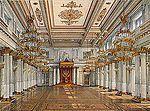First Winter Bridge

The First Winter Bridge (Russian: 1-й Зимний мост) is a single-span stone bridge in Saint Petersburg, carrying Millionnaya Street across the Winter Canal. The current bridge was originally built in 1768 to cross a different watercourse, and was rebuilt and opened in its present location in 1784. There has been a bridge on the site of the present crossing since the digging of the Winter Canal between 1718 and 1719. It was initially a wooden drawbridge design, and was replaced by a triple-span fixed wooden bridge in the mid-eighteenth century. This was in turn replaced in the 1780s by a single-span stone arched bridge, which had originally been built over the nearby Red Canal. This bridge, designed by Yury Felten and I. G. Rossi, with its construction supervised by engineer T. I. Nasonov, was rendered obsolete after the Red Canal was filled in during the late 1770s. The bridge was subsequently disassembled, moved to the Winter Canal, and reassembled there. It has remained in its new location ever since, undergoing various changes in its name, before its current name appeared in 1940. It was repaired in the 1950s, but has retained its architectural appearance from the eighteenth century, and has been designated an object of historical and cultural heritage of federal significance.
Excerpt from the Wikipedia article First Winter Bridge (License: CC BY-SA 3.0, Authors, Images).First Winter Bridge
набережная Зимней канавки, Saint Petersburg
Geographical coordinates (GPS) Address External links Nearby Places Show on map
Geographical coordinates (GPS)
| Latitude | Longitude |
|---|---|
| N 59.941388888889 ° | E 30.318611111111 ° |
Address
1-й Зимний мост
набережная Зимней канавки
191186 Saint Petersburg (Palace District)
Saint Petersburg, Russia
Open on Google Maps









